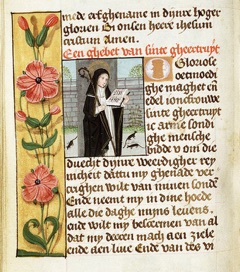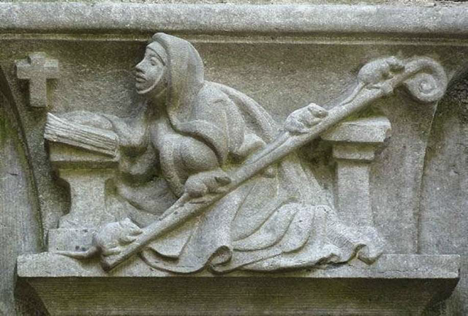Icon by Jennifer Richard-Morrow
ST. GERTRUDE OF NIVELLES
Patron Saint of Cats
626 AD-March 17, 659AD
By Rev. Brenda Griffin Warren
March 17th is not just St Patrick’s Day it is also the feast day for another Celtic saint, Gertrude of Nivelles. Interestingly, Gertrude asked an Irish monk on March 16 when she would die and he said tomorrow. She knew that was St. Patrick’s feast day and she was elated. The monk told her that St. Patrick and the angels would be greeting her.
St. Gertrude of Nivelles is best known as the Patron saint of cats. Now, that intrigues me as I love animals of all kinds, yet I have two cats who share their life with me or should I say they let me serve them. Yet, interestingly, no one knows why Gertrude is the Patron Saint of Cats, as there is nothing written about her with felines. The only guess for this designation is that there are some medieval depictions of her surrounded by mice. It was not even until the 1980’s that St. Gertrude became the Patron saint of cats.
So, let’s take a look at what we know about this saint who is not as well-known as some other female saints. St. Gertrude of Nivelles was born into aristocracy in Belgium in about 626AD. She was the daughter of Pepin of Landen, the mayor of the Austrasia palace (whose descendants through his daughter Begga’s marriage to Ansegisel later became the founders of the Carolingian Empire) and his wife Itta of Metz. There must have been strong-willed genes in that family as Gertrude herself was strong-minded from childhood.
One day when Gertrude was ten years old, King Dagobert I, King of Austrasia, king of all the Franks, and king of Neustria and Burgundy came to have dinner with her family. A young man who was the son of the Duke of Austrasia was at a dinner party with the family. He asked the King to grant him Gertrude’s hand in marriage. When Pepin asked his daughter if she agreed to this engagement, she angrily rejected the proposal and with an oath said that she would neither have him nor any other earthly spouse, only Christ. Yes, she was only ten!
As Gertrude grew older, she and her Mother Itta set up an Irish- inspired monastery in the ancient Sonian Forest at Nivelles. It is said that it was filled with treasured handwritten books. Itta was the first Abbess and then Gertrude followed in her footsteps. This Mother and daughter became good friends with the famous Irish missionary St. Fursey and his brothers Foillan and Ultan who first served in East Anglia in southeastern England and then in France.
Gertrude soon began to assign her abbess tasks to others so that she could spend more time in spiritual tasks such as in prayer, in reading, and in scholarly study. She began to build and to support numerous churches that she dedicated to the saints and she ministered to orphans, widows, captives, and pilgrims..

Page from Manuscript with St. Gertrude and mice. National Museum of the Netherlands
When Gertrude became fatigued and ill at age 33 in 659 AD from extensive caring for others, she appointed her niece Wulftrude (the daughter of her brother Grimoald I) as Abbess. That same year, Gertrude asked a pilgrim (likely Ultan) from Fosses Monastery when she would die and he prophesied that she would die the very next day on March 17, 659 on Irish St. Patrick’s feast day. He also said that Patrick along with the angels would greet her and just as he prophesied she did die on St. Patrick’s feast day.
Gertrude left instructions on how she wanted her nuns to bury her in an old veil that a pilgrim nun had left at Nivelles along with a scratchy hair shirt. Her vita says that at her death there was a most pleasant odor,” a s if a burning mixture of scents, and it perfumed that little cell where the holy body lay. And we, having gone out from there, still sensed the sweetness of that wonderful scent in our nostrils.”
Her *vita beautifully describes this good Abbess:
“Gertrude did not cease to speak in constant praying and in preaching the word of God to her people. Rejoicing in hope, bearing up in tribulation, devoted in her heart, and calm in her appearance, she longed for her last day to be present, the day of her heavenly journey.”

Notice the mice on St. Gertrude of Nivelles’ staff. console oudegracht_321. photo from KATTENKRUID VIA WIKIMEDIA // CC BY 3.0
It was recorded that even after Gertrude’s short life of 33 years on earth, that she continued her charisma of caring for the suffering of others from the other side of the thin veil. Gertrude’s compassionate care from the heavenlies included saving lives at sea; stopping a fire in a monastery; curing a girl of her blindness; helping a young boy escape kidnappers; rescuing a man in chains; and resuscitating a servant boy along with many other good works.
And Jesus said, “when you have done it to the least of these, you have done it to Me.” Well done, good and faithful servant St. Gertrude of Nivelles.
*Vita Sanctae Geretrudis (The Life of St. Gertrud) and the Additamentum Nivialense de Fuilano (the Nivelles Supplement to the Vita Fursei concerning Foillan) in Fouracre, Paul and Richard A. Gerberding. Late Merovingian France: History and Hagiography 640-720.Manchester, UK: Manchester University Press, 1996.
Rev. Brenda Griffin Warren is an ordained Christian Church (Disciples of Christ) Pastor who now serves in Interim Ministry. She is married with two grown sons, a daughter-in-love, and two Maine Coon cats who bear Celtic names. She writes on the Celtic and Anglo-Saxon saints at www.saintsbridge.org.


6 comments
I had never heard of this saint before your post. And that’s despite us checking out everything cat related. ?
Its always wonderful to discover something like this isn’t it?
Indeed 🙂
/The awesome icon of St. Gertrude of Nivelles with the ginger cat is by Jennifer Richard-Morrow.
Where can one purchase a copy of this icon?
Also, has anyone written a collect and compiled Scripture readings for her? One could use the general “Of a Monastic” propers, of course.
Bruce I think that if you did a google search you would find it